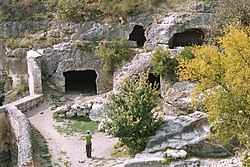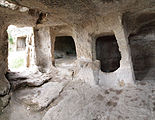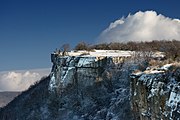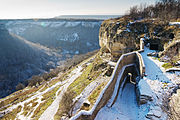Chufut-Kale
Çufut Qale
Чуфут-Кале | |
|---|---|
Historic settlement | |
 Chufut-Kale cave city | |
| Coordinates:44°44′28″N33°55′28″E/ 44.74111°N 33.92444°E | |
| Region | |
| Raion | Bakhchysarai Raion |
| Established | 6th - 10th century |
| Time zone | UTC+4(MSK) |
 | |
Chufut-Kale(Crimean Tatar:Çufut QaleTatar pronunciation:[tʃuˈfutqaˈle];RussianandUkrainian:Чуфут-Кале -Chufut-Kale;Karaim:Кала - קלעה -Kala[1]) is amedievalcity-fortress in theCrimean Mountainsthat now lies in ruins. It is a national monument ofCrimean Karaitesculture just 3 km (1.9 mi) east ofBakhchysarai.
Its name is Crimean Tatar andTurkishfor "JewishFortress "(çufut/çıfıt- Jew,qale/kale- fortress), while Crimean Karaites refer to it simply as "Fortress", considering the place as a historical center for the Crimean Karaite community.[2]In the Middle Ages the fortress was known asQırq Yer(Place of Forty) and as Karaites to which sect the greater part of its inhabitants belong,Sela' ha-Yehudim[3][4](Hebrewfor 'Rock of the Jews').[dubious–discuss]
Name versions
[edit]- Чуфут-Кале (Russian or Ukrainian transliteration: Chufut Kale) is mentioned in the Soviet scientific literature,[5]as well as in the works of Karaite authors in the Russian language from the second half of the 19th century to the post-Soviet epoch,[6][7]includingSeraya Shapshal's publications;[8]
- Juft Qale[Джуфт Кале] is used by modernCrimean Karaiteleaders, arguing that this is the original name of the town (in translation from Turkic -Double fortress), that over time it evolved into "a wrong but more easily pronounced name:Chufut-Kale[Чуфут Кале] orChuft-Kale[Чуфт Кале] ";[2]
- Qırq Yer, Qırq Or, Kyrk-Or, Gevher Kermen Çufut-Qale, Çıfut-Qalesi,[9]Orda-i muazzam Kirkyir[10]were the Crimean Tatar names during the Crimean Khanate;
- Kala(Karaim:קלעה,кала,kala- fortress);[1][7]
- Sela Yuhudim(Hebrew:סלע יהודים- «Rock of the Jews "(in the Karaite pronunciation) was used in Crimean Karaite literature until the second half of 19th century;[3][11][12]
- Sela ha-Karaim(Hebrew:סלע הקראים - "Rock of the Karaites" ) used by Crimean Karaites from the second half of 19th century;[13]
History
[edit]Researchers are not unanimous as to the time of the town's appearance. It was probably a fortified settlement in the 5th or 6th century on the periphery of theByzantine Empire.Others think that the fortified settlement appeared in the 10th-11th centuries.[citation needed]During the early period of the town's history, it was mainly populated byAlans,the most powerful of the lateSarmatian tribes,who spoke anEastern Iranian languagethat was the ancestor ofOssetian.They began penetrating Crimea in the2nd century.Settling down in this mountainous region, the Alans adoptedChristianity.In written sources, the cave town is mentioned in the 13th century under the name of Kyrk-Or ( "Forty Fortifications" ). This name lasted until the mid-17th century.
In 1299, theGolden Hordeforces underNogai Khanraided Crimea; at that time, Kyrk Or was then garrisoned by Byzantine soldiers. The stout fortress resisted direct storming by the Tatars, who then contrived to weaken the defenders by playing loud music for three days and nights. On the fourth morning, the defenders were too exhausted to repel a fresh attack, and the fortress succumbed to a general massacre. Having thus seized the town, the Tatars quartered their garrison in it. At the turn of the 15th century, Tatars settled Karaite craftsmen in front of the eastern line of fortifications and built a second defensive wall to protect their settlement, and thus a new part of the town appeared.[citation needed]
After theFall of Constantinoplein 1453, manyKaraite Jews,who were still Greek speakers, decided to migrate to Crimea, and in particular to thePrincipality of Theodoroand Chufut-Kale, as Crimea had a familiar Byzantine culture.[14]
In the 15th century, the firstCrimean Khan,Hacı I Giray,realizing the fortress’ advantages, turned the old section of the town into his fortified residence. After the defeat of the Golden Horde, the Crimean Khanate became considerably stronger. The significance of Kyrk-Or as a stronghold declined, and the Crimean Khan,Meñli I Giray,moved his capital to Bakhchysarai. The old town remained a citadel of Bakhchysarai and a place of incarceration for aristocratic prisoners.
In the mid-17th century, the Tatars left Kyrk-Or. Only the Karaites and severalKrymchakfamilies remained living there due to anti-Jewish restrictions on stays in other towns of the Crimean Khanate.[15][16]The town gradually acquired the name of Chufut-Kale, which in Turkic meant "Jewish fortress", with a negative and scornful meaning.[17]
After theAnnexation of the Crimean Khanate by the Russian Empirein 1783, the fortress inhabitants were permitted to live anywhere in the Crimea. From that time on, Chufut-Kale was deserted. By the mid-19th century the town ceased to exist.[citation needed]
Legends
[edit]There are many legends concerning the place. According to one, it was called "Qırq Yer" because the khansMeñli GirayorTokhtamysh,the founders of the city, brought with them fortyKaraitefamilies, and in their honor called it the "Place of Forty".[citation needed]
Another legend, fostered by the Karaites to show the antiquity of their sect, says that Karaites were brought there from Persia at the time of the first Exile. The early settlers of the city exercised great influence upon their neighbors, theKhazars.TheḥakamAbraham Firkovich,who was very skilful in falsifying epitaphs and manuscripts, pretended to have unearthed at the cemetery of Chufut-Kale tombstones dating from the year 6 of the common era and to have discovered the tomb of Sangari, which is still shown by the Karaites. According to Harkavy, however, no epitaph earlier than 1203 can be seen at the cemetery of Chufut-Kale, called "Vale of Jehoshaphat"; and the tombs do not belong to Karaites, but to the old Rabbinite settlers calledKrymchaks.Chufut-Kale, however, existed as early as the seventh century.Abu al-Fidamentions it under the name "Qırq Yer".[citation needed]
Gallery
[edit]-
Close-up view of thekenassas
-
Inside a cave
-
One of the kenassa buildings
-
Mausoleumof Dzhanike-Khanym, daughter ofTokhtamysh
-
A panorama of the caves and walls
In fiction
[edit]"Chufutkale" is mentioned (and also transliterated as "Chew-Foot-Calais" ) in Vladimir Nabokov's 1968 masterpiece, "Ada", page 338. The novel uses the site for the death of a minor character, Percy de Prey, during an imaginary Second Crimean War in 1888.[citation needed]
It is also mentioned in Jonathan Littel's great book "The kindly Ones" (2006) page 232 and is used to emphasize the regions intricate history.[citation needed]
Adam Mickiewiczwrote a sonnetDroga nad przepaścią w Czufut-Kale(The Pass Across the Abyss in Czufut-Kale), published in 1826.[18]
The second volume of Konstantin Paustovsky's autobiography, _Story of a Life_, contains a description of his visit to Chufut-Kale during World War I. The description occurs in chapter 65, "One Day."
See also
[edit]References
[edit]- ^abКараимско-русско-польский словарь / Н. А. Баскаков, А. Зайончковский, С. Ш. Шапшал, 1974, C. 683 (Географические названия)
- ^abCrimean Karaites (author—K. Efetov)
- ^ab«The origin and history of the Crimean Karaites "S.Beim 1862 Crimea. Chufut Kale.Bakhchisaray
- ^Энциклопедический словарь Ф.А. Брокгауза и И.А. Ефрона— С.-Пб.: Брокгауз-Ефрон. 1890—1907 ст. Чуфут Кале;
- ^Чуфут Кале // Большая советская энциклопедия
- ^Память о Чуфут-Кале /С. Бейм.— О.: [б.и.], 1862. — 82с., с.431-444
- ^abFirkovich M. YThe ancient Karaim town Kale now called "Chufut Kale".- Vilna, 1907
- ^Шапшал С. Караимы и Чуфут-Кале в Крыму. — СПб., 1895.
- ^"In the west end of the valleyBakhchisaray,half an hour from the city, is a place with 120 roads, with a castle on a high cliff. Now it is simply called Qale (fortress) or Chifut-Qalesi (Jewish Fortress), as it is populated only by Jews Karaite sect. »/ /Crimean KhanateJohann Tunman, 1784
- ^Türkiye Diyanet Vakfı İslâm ansiklopedisi(in Turkish). Vol. 14. 1996. p. 77.
- ^Abraham Firkovich.«Manjalis Document» («נוסח הרשימה הנמצאת במנג'יליס / על ידי כמורה "ר... אברהם פירקוויץ בשנת התר" א »)
- ^Энциклопедический словарь Ф. А. Брокгауза и И. А. Ефрона— С.-Пб.: Брокгауз-Ефрон. 1890—1907 ст. Чуфут Кале
- ^"Commemorative plaque in Chufut Kale kenasa after in honor of visiting by the Tsar's family in 1886".Archived fromthe originalon 2016-03-04.Retrieved2012-10-23.
- ^Dan Shapira (2003).Avraham Firkowicz in Istanbul (1830-1832): paving the way for Turkic nationalism.KaraM publication. p. 3.ISBN9756467037.
- ^Гурджи и ашкенази, или крымчаки в городе Чуфут-Кале/ М. Кизилов // Крымчаки, 2009. т.№ 4.-С.12-15.
- ^Меметов А.О так называемых «тюркских народах» КрымаArchived2011-10-19 at theWayback Machine.// Ученые записки Таврического национального университета им. В. И. Вернадского. Серия «Филология. Социальные коммуникации». Том 22 (61). № 3. 2009 г. С. 172—178.
- ^"Tatiana Schegoleva. Karaites of Crimea: History and Present-Day Situation in Community".Archived fromthe originalon 2017-07-04.Retrieved2012-11-03.
- ^Lenczewska, Olga (2 July 2015)."Adam Mickiewicz's" Crimean Sonnets "– a clash of two cultures and a poetic journey into the Romantic self".www.readingsjournal.net.Retrieved2021-07-19.
External links
[edit]- History and monuments of Chufut Kale(Чуфут-Кале)
- The map of the fortress
 This article incorporates text from a publication now in thepublic domain:Singer, Isidore;et al., eds. (1901–1906)."Chufut-Kale".The Jewish Encyclopedia.New York: Funk & Wagnalls.
This article incorporates text from a publication now in thepublic domain:Singer, Isidore;et al., eds. (1901–1906)."Chufut-Kale".The Jewish Encyclopedia.New York: Funk & Wagnalls.









